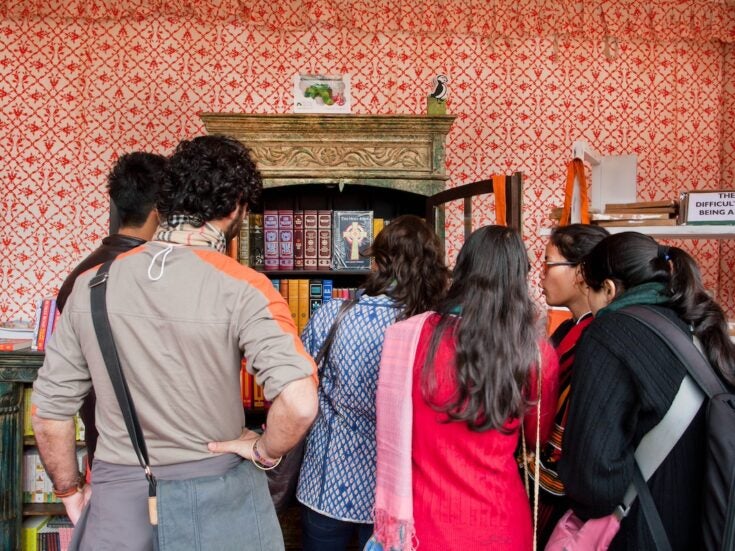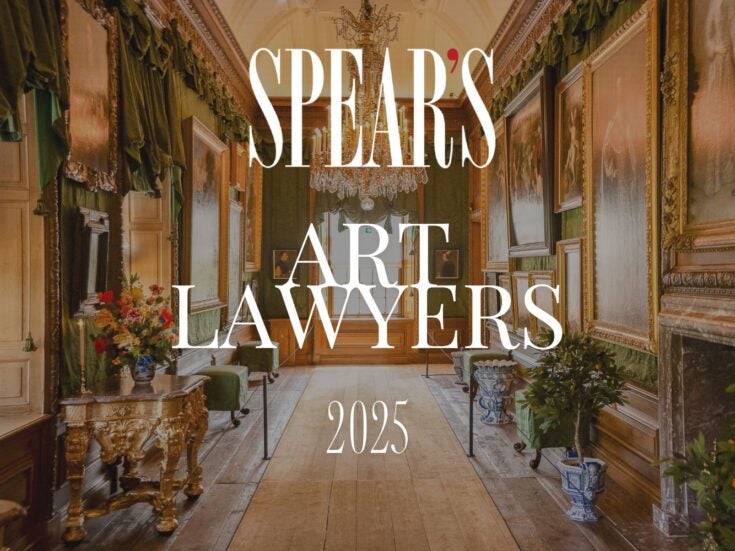
Let’s Do Launch
Manhattan has gone dotty for a new book on Edwina Sandys, the flame-haired painter, sculptor and granddaughter of Winston Churchill. Quite right, too, says Anthony Haden-Guest
THE MANHATTAN PUBLICATION of Edwina Sandys’ Art was celebrated by so many parties that it was like a fire in a fireworks shop, and as I write they are still going off. Sandys first astonished me in London, as a member of the Chelsea Set, that scene-setter for the Swinging Sixties, a variegated and colourful group of which she was by no means the least vivid member. And — full disclosure — I should add that I came to know her because she frequented the Bistro, a small restaurant off Sloane Square run by a formidable woman. OK, that was my mother.
Sandys was an artist and was married to Piers Dixon, the son of Pierson Dixon, the then British ambassador to Paris. They lived in a house on Chester Row in which their two sons, Mark and Hugo, were born. It’s not coincidental that her grandfather was one of the 20th century’s better-known amateur painters, Winston Churchill.

‘I often watched him painting,’ says Sandys, who frequently stayed in the Churchills’ country house, Chartwell, as a child. ‘He was totally absorbed.’ She came to understand that for him the act of painting was not merely a way of removing himself from the mundane, from the cares of office, but it was also a way of channelling his extraordinary appetite for life. Churchill was also that rarity among politicians, a powerful writer, and she loves a vintage Churchillian quote: ‘History will be kind to me, for I intend to write it.’
It might also be to the point that Churchill painted as if the avant-garde contemporary art world, then relatively puny in size and geographically fragmented compared to the muscular global entity it has become today, was irrelevant to what he was doing. The art world now is a huge information exchange and impossible to ignore, but Sandys simply doesn’t play the games. She is as focused on expressing her own innerness as any Outsider artist, which, in our highly strategised, overly careerist artscape, is deeply refreshing.
She had established her style early, and it’s a highly individual one. Her colours are bright and warm — her blues suggest not cold seas but summer skies and her reds don’t call blood to mind but ripe fruit, red telephones, library walls — and her line is fluid, fluent and witty.
As to the subject matter, well, the book is retrospective. One early piece shows Harold Wilson playing a hand of Union flag-backed cards and many of the faces, like Mark Boxer’s caricatures of the same decades, resonate an indefinable but unmistakeable ‘Britishry’.
And then, of course, you have the femaleness. British women artists — Gwen John, Barbara Hepworth, various Bloomsburys — indeed, a great many pre-YBA male artists had been given to genteel Good Taste, a kind of wihtholdingness. Not so Sandys. She is as blatant in her femaleness as such New York artists as Louise Bourgeois, Hannah Wilke and Kiki Smith, but whereas they’re inclined to take you on journeys to the dark side of female experience, Sandys is playfully, indeed generously, inviting her viewers to some kind of naughty picnic in her head — as when God, borrowed from Michelangelo, creates an Eve, who has Sandys-ish hair, by preparing to poke what looks like an already fully erect nipple.
Sandys frequently visited New York and it was the Manhattan dealer Robert Elkon who introduced her to Andras Kalman, a London dealer with a couple of galleries, Crane Kalman, near the Brompton Oratory, and Crane Arts on the Kings Road. The Hungarian-born dealer was taken with Sandys’ combination of an appetite for work and cavalier attitude and he showed her work in both galleries.

Sandys was painting and also modelling clay and casting in bronze. In 1973 she got the idea of sculpting a naked woman, nailed to a cross. Christa was completed in 1975. It was shown in London, then in churches and galleries from Rome to Washington and New York, and the utterly unerotic piece provoked the same kind of convulsively mixed reactions worldwide as Andres Serrano’s Piss Christ. ‘For me Christa symbolises the sacrifice of women,’ says Sandys.
ALSO IN THE mid-Seventies, Sandys, newly separated from her husband, took a small house in Umbria, visited the famous quarries of Carrara and added marble to her repertoire. Her treatment of the hallowed material is characteristically irreverent, using it as a drawing board, incising lines into it, or making flat cuts, as in Hands On, in which two four-fingered cutouts suggest by their absence a woman’s breasts. Sandys is as given to negative spaces as Henry Moore but a bit more wittily, as in Delilah, in which a woman is also a pair of scissors about to sever a hank of hair with her crotch.
And so to New York. I had been living in Manhattan for a year when she arrived in 1978 and took a smallish flat on 46th Street, overlooking the UN. It was partly her art career that had turned Manhattan from a frequent destination into a stop-off place. ‘I had clients here, I came to add another string to my bow,’ she says. ‘But I didn’t leave London. I kept my place in Chelsea.’
There was nothing radical about the move. In fact, it seemed appropriate. Churchill’s mother, Jenny Jerome, was American. ‘The family were very proud of that. And they were particularly proud that she — and so we — were partly what we used to call Red Indian.’

There were plenty of other American links. Churchill had been made an honorary citizen, while her son Mark was then living and working in Manhattan, so what Sandys calls her ‘Tale of Two Cities’ period was a comfortable one.
SANDYS HAD A fully developed style but soon found that New York was making its urgently clamorous presence felt in her work. ‘You’re not living under a low ceiling,’ she says. ‘You look at all the skyscrapers. You somehow feel that you’ve got to expand your work.’ After two years in Manhattan she got a commission to make three monumental sculptures for the United Nations. The first of these, Child, was installed outside the UN International School in 1980. It’s another white marble cutout, created by the shapes of the parents. She was in business. Would that have happened so quickly in London? Oh, do stop joking.
Sandys married an American, Richard Kaplan, in the mid-Eighties and lives and works on Downtown Broadway, in a tall-ceilinged Cast Iron District classic, the ceiling of which Kaplan, an architect, has restored to majestic industrial rawness. Sandys’ paintings and sculptures — including Target of Abuse, a female cutout with three dart-penetrated targets on its torso — are everywhere. A book party was foaming around me. Long-legged girls. Massimo Vignelli, the Italian designer. Harry Benson, the Scottish photographer. The artist Christo was praising the bravery of, yes, Christa. It wasn’t Anglo, it wasn’t America, it was New York.
Anthony Haden-Guest is Spear’s arts editor







